Poultry ventilation
The 8 most often asked Questions on Ventilation in the Field
- Why is ventilation for the chick embryo as of 12 days of age in the setter and hatchery machines so important?
- Ventilation & temperature control during transport from hatchery to farm (truck).
- What is minimum ventilation in broiler houses?
- How to calculate the number of fans needed?
- What causes wet litter behind the evaporative pads?
- How to do maintenance on evaporative pads to keep efficiency up?
- What causes air distribution problems through the house and bird migration?
- Causes of too much temperature differential between both ends of the house?
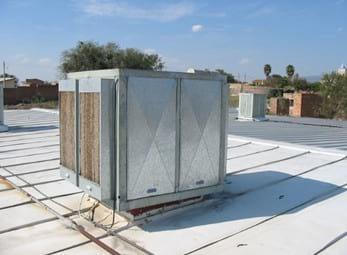
Photo 1: Evaporative cooling Unit on the roof of a hatchery
Ventilation in the hatchery is based on fresh air for the embryos and chicks, for temperature and relative humidity (RH) control and to maintain the right room pressures. Evaporative Cooling Units will only give fresh air and some temperature control under hot conditions. These units will need to be controlled in 3 stages: At slow speed, at high speed and then with the pumps running when temperature of incoming air will surpass 28ºC. The low speed should always be in operation to supply enough oxygen to the setter and hatcher rooms.
 | 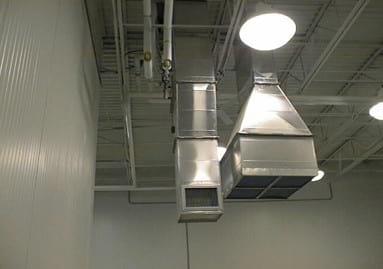 |
HVAC units do all the important aspects of environment control in the hatchery: H stands for Heating, V for Ventilation and AC for Air Conditioning. They also control the air pressure within the room that is set by a PEC (pressure equalizing control) unit.
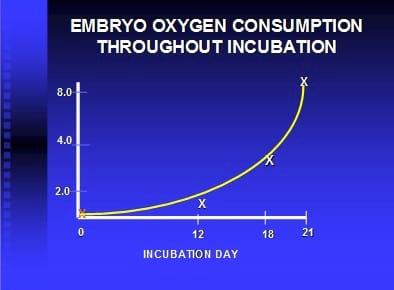
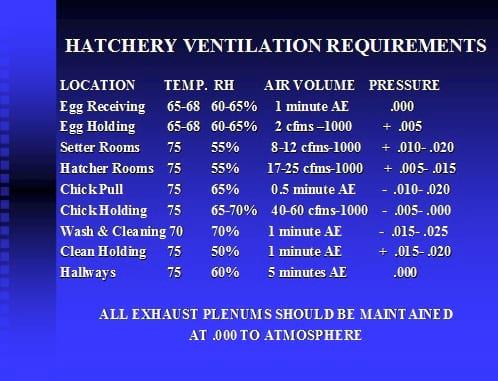
Table 1: This important table basically mentions how to manage the environment in each room of the hatchery in order to have optimum quality chicks. Investing in environment often results in better hatchability but this is not always the case. Investment in environmental control will be seen mainly at chick level (quality) and better field performance of the broilers. Pay back can be very fast based on the local conditions (altitude for example) and is one of the overlooked areas in many companies.

Photo 4: Excessive temperatures in the holding area of the hatchery due to insufficient air flow or circulation and in the chick truck are probably the 2 main reasons of reduced chick quality arriving at the farm. Chicks in these cases do not only dehydrate but are often deprived of adequate oxygen levels affecting the respiratory tract, which includes the lungs. In traditional natural ventilated trucks body temperature of the chicks vary from 95ºF=35ºC in the lower part and up to 104ºF=40ºC in the upper part of the truck body.
Truck Ventilation systems, Maximum Temperatures & required Air Exchange per 1000 Chicks

- Since heat always rises upwards it is much easier to move this heat upwards through the chick boxes instead of the other way around, trying to push fresh incoming air down. This means that air intake into the truck body is at the bottom and the exhaust at the top.
- There should be a positive air pressure (+0.15) if a positive air distribution intake plenum is used.
- The holes in the intake plenum (positive pressure) should be equal to the holes in the exhaust plenum (negative pressure) to assure even distribution of the air through the whole chick cargo. This is extremely important to have even temperatures and fresh air.
- The floor of the truck (especially rear axle) should be very well insulated to avoid heat buildup from the road over long hauls during hot weather.
- There should be a RH control, set at 65%, to avoid dehydration of chicks during transport.
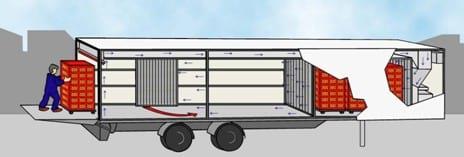
- If the body temperature of the chicks is too high the chicks lose body energy (panting) and are more susceptible with less start up growth in the first few days in the broiler house.
- If the body temperature is too low, the body energy is also diverted and used to maintain body temperature and the immune system and initial body weights are affected (7 days of age).
- If chicks are stored too hot in the chick room of the hatchery or in the chick truck (when standing still due to traffic problems), naturally ventilated chick trucks will not be capable to remove excess heat production build up.
- If the body temperature of the chicks is correct you will hardly hear the chicks and they will sleep most of the time. Hearing noisy chicks is a sign of stress (temperature or oxygen deprivation).
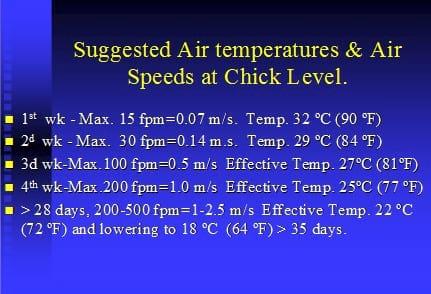
Table 2: Baby chicks in the first 2 weeks of the rearing should receive almost zero air speeds from the ventilation system. If only 1 fan ran from the tunnel ventilation system, the airspeeds would surpass easily 50 fpm, and that is 4 times as much as the chicks should feel. The consequences are inconsistent broiler results that most of the time do not get even close to the body weight (BW) and feed conversion (FC) standards of the breed.
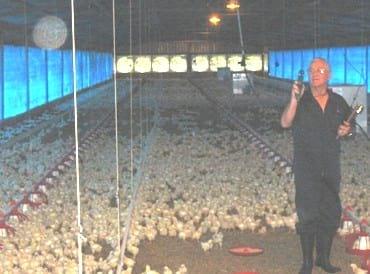
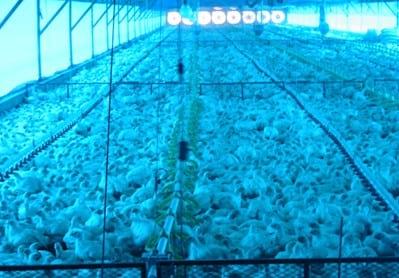
Photo 6: Older broilers that receive too much airspeed (chilling) stay down on the floor and this effect feed and water intake.
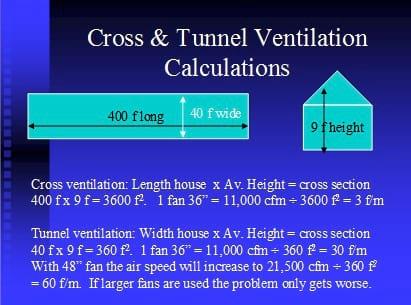
Design 1: Explaining the difference in air speed based on tunnel and cross ventilation.

Design 2: Cross flow ventilation to obtain air exchange & temperature control at the same time
- Calculate the cross section of the house: Average height x width. Ex: 40 f x 9 f =360 f2
- Multiply the cross section by the maximum air speed required: 360 f2 x 500 fpm = 180,000 cfm's total fan capacity needed.
- Take total fan capacity and divide by cross section to get the speed in the house.
- Examples: 9 fans x 20,000 cfm at 0.10 negative pressure =180,000 cfm's ÷ 360 f2=500 fpm. (OK).
- Example: 8 fans x 20,000 cfm at 0.10 neg pressure =160,000 ÷ 360 f2= 444 fpm (not enough). To get to 500 fpm baffles could be installed. The height of the baffles is calculated and not just ad random: Take 160,000 cfm's and divide by 500 fpm (needed maximum air speed) = 320 f2 divided by the width of the house 40 f = 8 f the height at which the baffles should start.
- Anytime the air speed is over 500 feet per minute (2.5 m/s) the pressure drop increases 0.02 for every 100 feet (32 m) you move the air.
- For 500 f long house this would increase the pressure to (5x0.02 =) 0.10, so pressure would move above 0.20 in total. All fans will reduce their efficiency and fan capacity.
- Any baffles added at any height will slow the air down even more and create an even higher pressure drop and could double the cost of running the fans.
- Having higher airspeeds than 500 fpm is of course possible but this comes normally at higher electricity and investment costs.
- Wrong pad area in relation to the total fan capacity.
- No use of inlet curtains that assures proper ventilation behind the pad area of the house.
- Pads wrongly installed (up side down in case of 45/15 pad ) or the wrong type.
- Wrong timer program for wetting and drying.
- Wrong setting of temperature and RH shut off.
- Water too cold and pad area covered against the sun.
- Calcified pads or dirty without enough maintenance.

Design 3: The inlet pad area is determined by the total fan capacity installed. Only at total fan capacity running should the pump operate in order to make full use of maximum evaporation. The pads are calculated to work at maximum efficiency with an airspeed going through them at 400 fpm (2 m/s). Within the pads a friction is induced to elevate the temperature of the incoming air to enhance evaporation of the water and thus cooling of the air leaving the pad towards the inside of the house.
- No use of inlet curtains that assures that there is proper ventilation behind the pad area of the house.
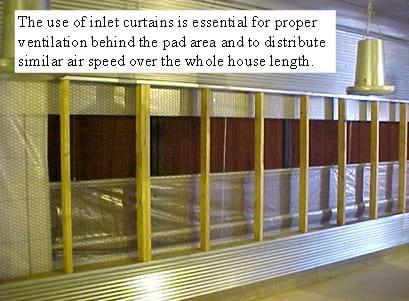
- Pads wrongly installed or the wrong type.
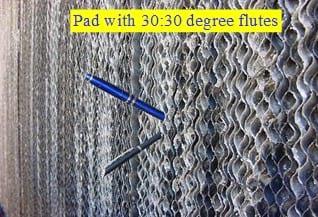
Photo 8: Under normal temperature and RH conditions pads of a 30-30 degrees angle should be used. Under very dry conditions (<30% RH) and high temperatures (>35ºC) a 45-15 angle pad is used with the 45 degree angle always positioned towards the outside. If pads are upside down with the 45 degree pad and directed towards the inside of the house more humidity will be brought into the house. With the 30-30 configuration it does not matter how installation is done.
- Wrong timer program for wetting and drying.

- Wrong setting of temperature and RH shut off.
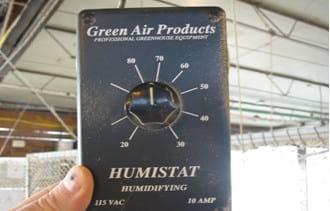
- Managing the pumps by hand or having no humidity shut off.
- Letting pumps run when RH is over 70%.
- Letting pumps run when temperature is below 82ºF or 28ºC.
- Humidistat in the wrong area of the house (should be placed 6 f (2 m) behind where the pad area ends.
- Water too cold and pad area covered against the sun.
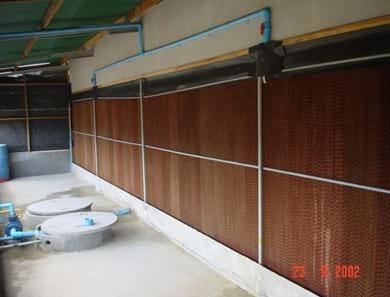
- Pads, that are calcified or dirty without enough maintenance


- 1. Normally clean pads annually with surfactant (wetting agent) which clears the pores of the pads and enhances evaporation capacity.
- 2. Add half cup of surfactant to the tank and let the pump run for 2 hours.
- 3. Use a low pressure water hose to clean the flutes (up and downwards). Best way to do this is from the inside out.ç
- 4. Clean the water tank completely (water is black or dark).
- 5. Add clean water again and you are good to go.
- No inlet curtains that regulate the uniformity of the air distribution in the house (design 4)
- Excess airspeed in the center of the house (at any age) (design 4).
- Too high a temperature differential between both ends of the house.
- The inlet curtain is too low, drawing the birds towards the pad area.
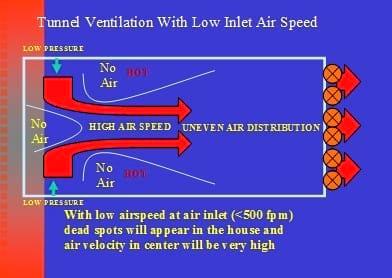

Photo 14: No birds in center of the house.
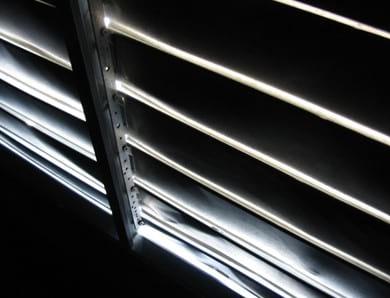
- Too many air leaks in the house permit hot air to come in (air speed will go up moving towards the fans).
- Airspeed going down towards the fans means over restriction of the inlet curtains.
Table 3: The following table will give the temperature reduction that may be accomplished with evaporative cooling when dry-bulb temperatures and RH are known. With a good fogging system you can expect about 55% of the table values.
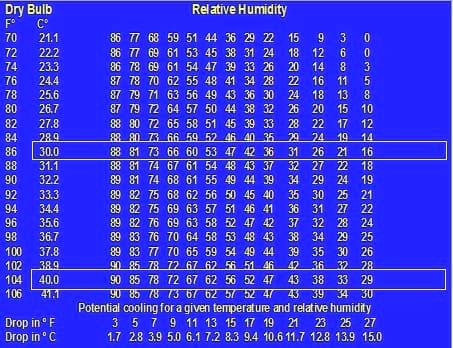
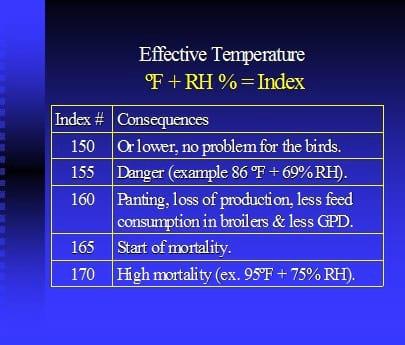
Note: This article will NOT guarantee specific results and must be seen as a reference only.
Dear Mohamed Wafi,
If the relative humidity is very high you will need to see how you can make the chick holding room more environmental controlled. I do not know how much money you have available to do this, but I would suggests that you ventilate enough to keep the oxigen level up with bringing in outside air and then install some AC units that will reduce the relative humidity in the room and control your temperature. The article mentions the guide lines for temperature and RH and how much air the room needs per 1000 chicks. If chicks are confortable you hardly hear them in the chick holding room. Some companies use blue lights when the room is full with chicks and they need to stay over for several hours. Hearing a lot of chick noise means they are not comfortable. They can be too cold, too hot or not having good air quality or a combination of above 3 points I do not know your conditions, but try to combine the 3 above mentioned factors and experiment a bit at what levels you see that the chicks are comfortable and room is quiet.
Winfridus Bakker
What is the standard negative pressure (pascal) 1 meter width of cage house for broiler management?
Could you please give some details of chick processing room and chick holding room environmental condition suitable for tropical condition as over RH is very high? I would need to know the ventilation and temperature arrangements.
Thanks,
A.B.M.Wafi
Colombo
















.jpg&w=3840&q=75)